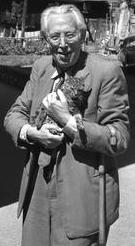Kurt Reidemeister facts for kids
Quick facts for kids
Kurt Werner Friedrich Reidemeister
|
|
|---|---|

Kurt Reidemeister in 1956 or 1958 in Switzerland
|
|
| Born | 13 October 1893 |
| Died | 8 July 1971 (aged 77) |
| Nationality | German |
| Alma mater | University of Hamburg |
| Spouse(s) | Elisabeth Wagner |
| Scientific career | |
| Fields | Mathematics |
| Thesis | Über die Relativklassenzahl gewisser relativ-quadratischer Zahlkörper (1921) |
| Doctoral advisor | Erich Hecke |
| Doctoral students | Günter Hotz Heiner Zieschang |
Kurt Werner Friedrich Reidemeister (born October 13, 1893 – died July 8, 1971) was a German mathematician. He was born in Braunschweig, Germany. He is known for his important work in different areas of mathematics, especially in understanding shapes and groups of numbers.
Contents
Kurt Reidemeister's Early Life and Education
Kurt Reidemeister was the brother of Marie Neurath. He began his studies in 1912. He attended universities in Freiburg, Munich, Marburg, and Göttingen.
In 1920, he earned his master's degree. This degree covered several subjects, including mathematics, philosophy, physics, chemistry, and geology.
He continued his studies and received his doctorate (Ph.D.) in 1921. He earned this advanced degree from the University of Hamburg. His main area of study was a special part of mathematics called algebraic number theory. His advisor was Erich Hecke.
Becoming a Professor and His Work
Kurt Reidemeister became very interested in differential geometry. This is a field of mathematics that studies curved shapes and spaces. He helped edit a book on this topic with another mathematician, Wilhelm Blaschke.
In 1922 or 1923, he became an assistant professor at the University of Vienna. While there, he learned about knot theory from Wilhelm Wirtinger. Knot theory is the mathematical study of knots. He also became close with Hans Hahn and the Vienna Circle. This was a group of thinkers who discussed science and philosophy.
In 1925, he became a full professor at the University of Königsberg. He taught there until 1933. At that time, the Nazis came to power in Germany. They did not agree with his political views, so he was removed from his teaching job.
Later Career and Contributions
After being dismissed, another mathematician, Blaschke, helped him. In 1934, Reidemeister was able to get a new teaching position. He became a professor at the University of Marburg.
He stayed at Marburg for many years. He also visited the Princeton Institute for Advanced Study in the United States from 1948 to 1950. In 1955, he moved to Göttingen University. He taught there until he retired.
Kurt Reidemeister's Main Ideas
Reidemeister's main interests were in several areas of mathematics:
- Combinatorial group theory: This looks at groups using combinations.
- Combinatorial topology: This studies shapes and spaces using combinations.
- Geometric group theory: This combines geometry and group theory.
- Foundations of geometry: This explores the basic rules and ideas of geometry.
He wrote several important books on these topics:
- Knoten und Gruppen (1926)
- Einführung in die kombinatorische Topologie (1932)
- Knotentheorie (1932)
He also helped edit a well-known mathematics journal called Mathematische Annalen from 1947 to 1963.
Besides mathematics, Kurt Reidemeister was also a philosopher. He wrote a book called "Das exakte Denken der Griechen" (1949). In this book, he shared his thoughts on how mathematical thinking is just the start of all thinking.
See also
- Reidemeister moves
- Reidemeister–Singer theorem
- Reidemeister torsion

